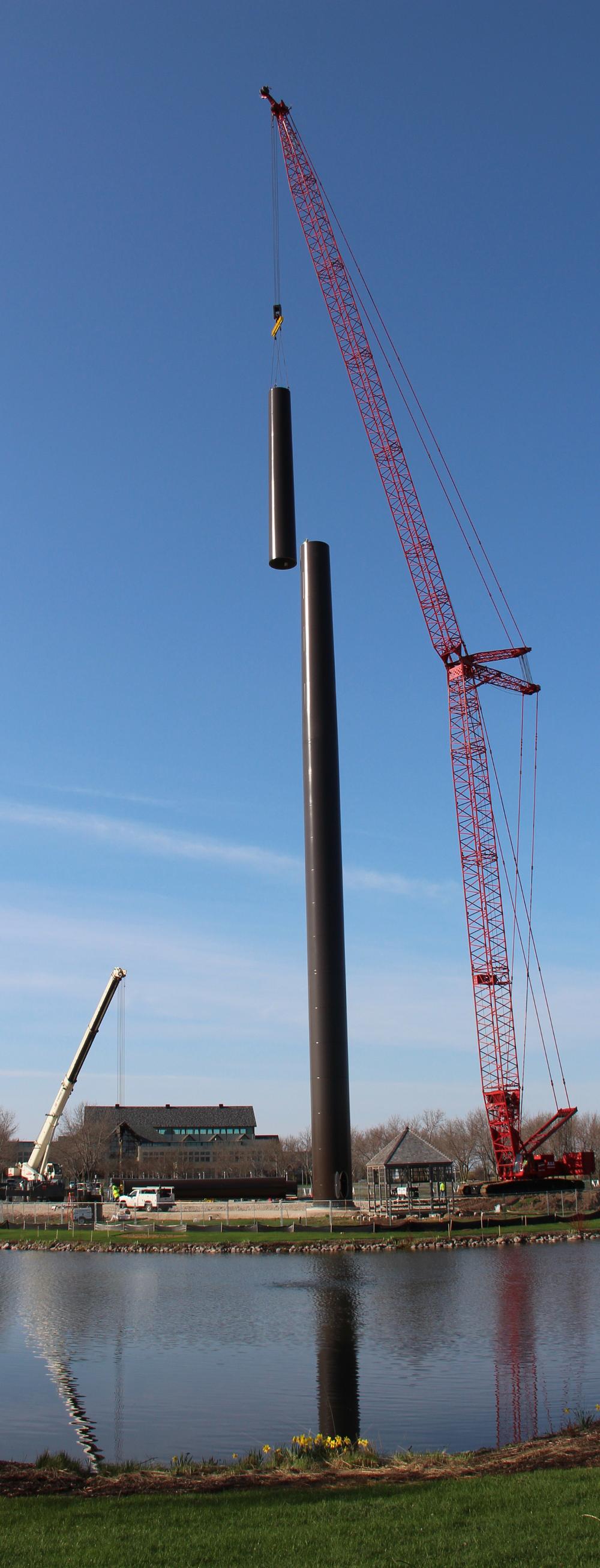- FMA
- The Fabricator
- FABTECH
- Canadian Metalworking
Categories
- Additive Manufacturing
- Aluminum Welding
- Arc Welding
- Assembly and Joining
- Automation and Robotics
- Bending and Forming
- Consumables
- Cutting and Weld Prep
- Electric Vehicles
- En Español
- Finishing
- Hydroforming
- Laser Cutting
- Laser Welding
- Machining
- Manufacturing Software
- Materials Handling
- Metals/Materials
- Oxyfuel Cutting
- Plasma Cutting
- Power Tools
- Punching and Other Holemaking
- Roll Forming
- Safety
- Sawing
- Shearing
- Shop Management
- Testing and Measuring
- Tube and Pipe Fabrication
- Tube and Pipe Production
- Waterjet Cutting
Industry Directory
Webcasts
Podcasts
FAB 40
Advertise
Subscribe
Account Login
Search
From the Web: Tallest flagpole in NA; hydroformers on Sci Channel; society needs welding to function
- By Vicki Bell
- May 20, 2014
At 400-ft.-tall, the tallest flagpole in North America will be finished and erected next month at the Acuity Insurance headquarters in Sheboygan, Wis. It will fly a flag that is 60 ft. by 120 ft. and weighs 500 lbs.
More than a dozen engineers and contractors are working on the project, including the Seattle office of international engineering firm Arup as technical adviser.
One reason Arup got the job is it has wind engineers that have helped design other tall slender projects, including The Spire of Dublin — a large, stainless steel, pin-like monument designed by Ian Ritchie Architects for downtown Dublin. Arup also is a technical adviser on the world's tallest flagpole, which is nearing completion in Jeddah, Saudi Arabia. It will be 557 feet tall.
American Hydroformers has announced that the company and its Fort Wayne, Ind., hydroforming facility will be featured on an upcoming episode of the Science Channel’s documentary television series "How It's Made." The segment offers a behind-the-scenes look at tube hydroforming. Viewers will be given the opportunity to see a step-by-step demonstration of the process, as well as learn more about its uses and the industry in general.
The segment will air in 2014. The current programming schedule can be found here.
In an opinion piece in The Edgefield Advertiser, Bill Cheatham, an instructor in the Welding Technology Program at the Strom Thurmond Career and Technology Center (STCTC), Johnston, S.C., makes the case for the importance of welding: “Our society would not function without welding. Everything from automobiles, rockets, aircraft, skyscrapers, bridges, and highways require welding, as (do) oil and gas pipelines, wind turbines, and solar panels.
”The tasks welders can perform have increased significantly with the development of new technologies. Successful welders today operate robots and other automated systems, powerful lasers, electron beams, and sometimes explosives to bond metals. Approximately 20 percent of welding is automated at this time, which requires welders to have computer skills.”
Noting that there are more than 80 welding processes and a wide variety of welding jobs ranging from construction to manufacturing to shipbuilding, Cheatham said that “a major common characteristic of all these fields is the median salaries for different industries that range from high $40s to mid $80s.” (Making the assumption here that he is talking about an annual salary of $40,000 to $80,000). “A college graduate with a welding engineering degree will fetch a starting salary in the mid $50s.”Cheatham wouldn’t have to work too hard to convince students in Anoka Technical College, Anoka, Minn., of the importance of welding or its desirability as a career option. Many of its current students, including 15 second-year students graduating this month, six first-year students, along with one recent graduate, have already been recruited by unions for two primary reasons: “The students’ exemplary skills and the shortage of skilled workers in the improving economy.”
Finally, Florida tattoo artist and metal fabricator has some advice for today’s youth: “Put down the Snapchat, throw out the videogame console, and actually build something.” He laments, “We are raising a generation of pencil pushers.”
Jeffers is part of Makers Square, a membership-based tool shop and craft school in Fort Lauderdale, Fla., run by bohemian misfits who love making things by hand. The group is participating this Saturday in the “Makers at MODS” showcase at the Museum of Discovery and Science in Fort Lauderdale, a daylong festival designed to show the community the hands-on application of the industrial arts and technology.
”The makers' movement is an antidote to today's computer-centric, sedentary lifestyles, which, Jeffers says, came about due to a variety of factors, including a decline in shop classes and home economics and an economy that has outsourced manufacturing jobs.
"‘A lot of metal fabrication has gone to China," Jeffers observed. ‘And that's a shame, because working with one's hands is good for mental health and confidence and even the wallet. Fabricating things with metal benefits me because it exercises my brain. I can go to the store and see something on the shelf and figure out how to make it. And I'm make a living doing it. I feed my kids.’"
On Saturday, Jeffers will be assembling tattoo machines. He taught himself how to work with metals and has sold his machines online for the past 14 years.
subscribe now

The Fabricator is North America's leading magazine for the metal forming and fabricating industry. The magazine delivers the news, technical articles, and case histories that enable fabricators to do their jobs more efficiently. The Fabricator has served the industry since 1970.
start your free subscriptionAbout the Author

Vicki Bell
2135 Point Blvd
Elgin, IL 60123
815-227-8209
- Stay connected from anywhere

Easily access valuable industry resources now with full access to the digital edition of The Fabricator.

Easily access valuable industry resources now with full access to the digital edition of The Welder.

Easily access valuable industry resources now with full access to the digital edition of The Tube and Pipe Journal.
- Podcasting
- Podcast:
- The Fabricator Podcast
- Published:
- 04/16/2024
- Running Time:
- 63:29
In this episode of The Fabricator Podcast, Caleb Chamberlain, co-founder and CEO of OSH Cut, discusses his company’s...
- Industry Events
16th Annual Safety Conference
- April 30 - May 1, 2024
- Elgin,
Pipe and Tube Conference
- May 21 - 22, 2024
- Omaha, NE
World-Class Roll Forming Workshop
- June 5 - 6, 2024
- Louisville, KY
Advanced Laser Application Workshop
- June 25 - 27, 2024
- Novi, MI

































